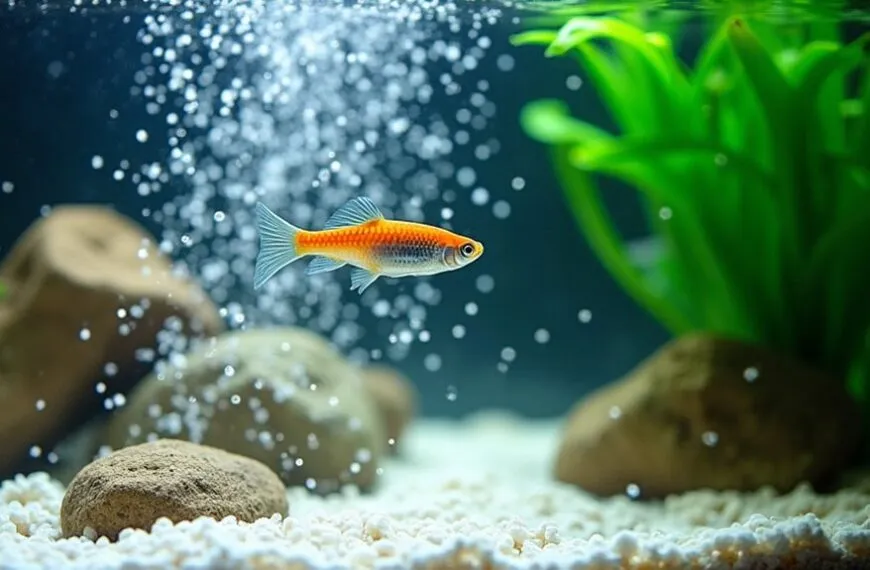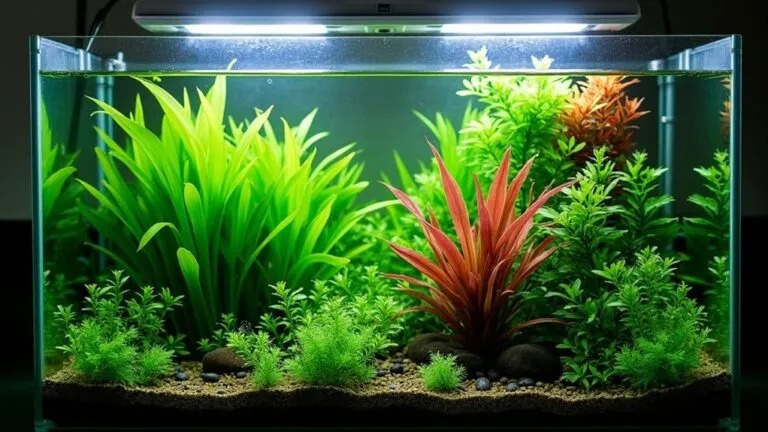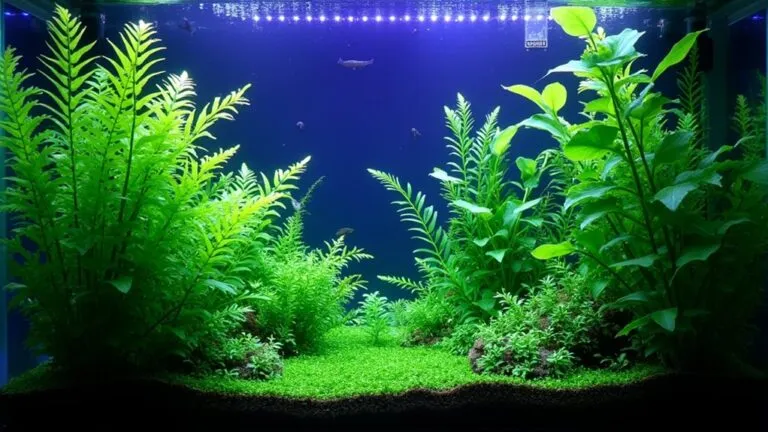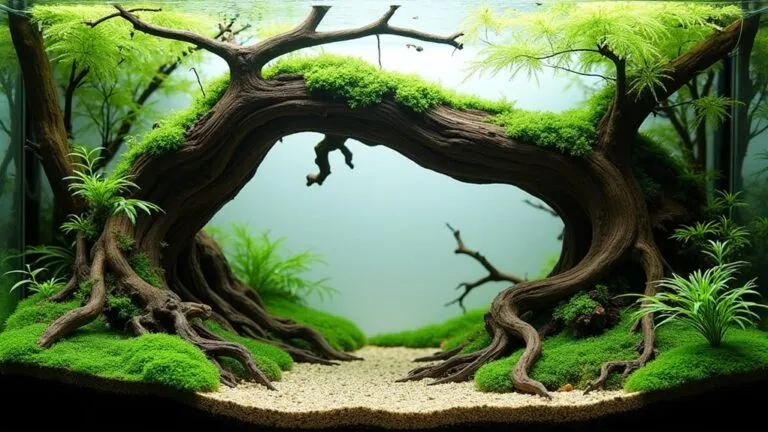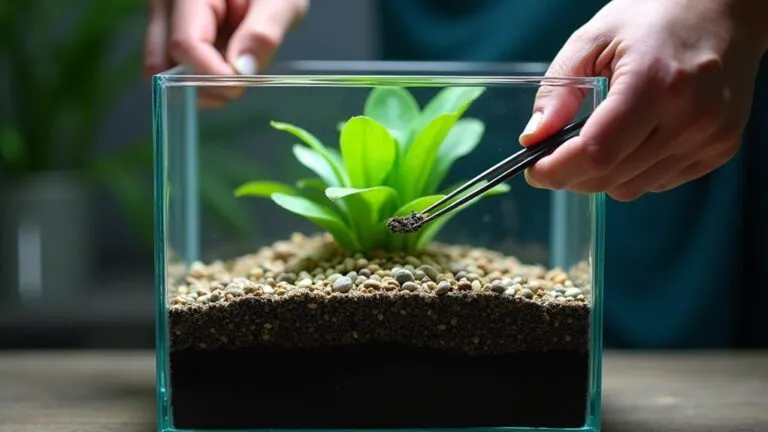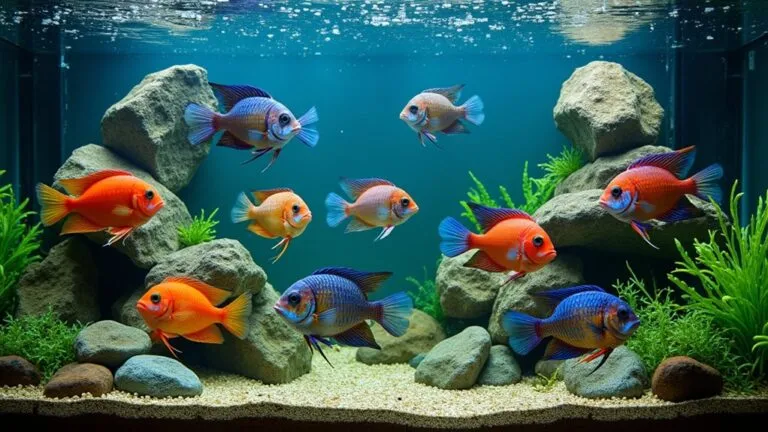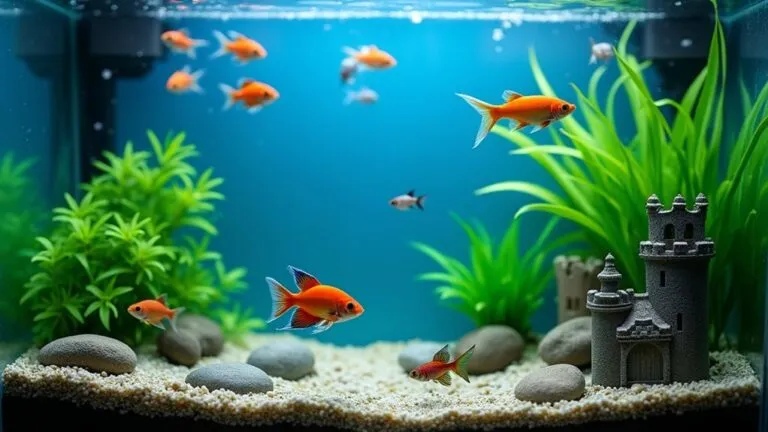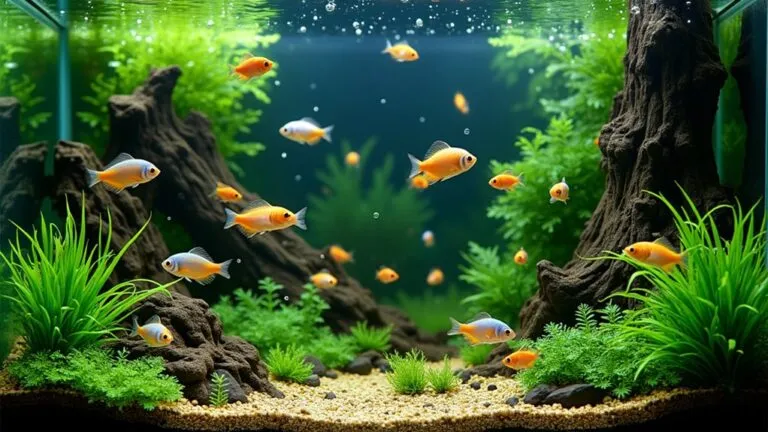You don't need to remove your fish during routine tank cleaning – they can safely stay in their home while you work! For standard maintenance like water changes and gravel siphoning, keeping fish in their familiar environment actually reduces stress. Just use slow, deliberate movements and maintain some hiding spots with decorations so they can retreat if they feel anxious. If you must relocate them for major cleaning, use clean buckets filled with original tank water, and add an air stone for oxygen. While in-tank cleaning is usually best, knowing how to properly set up temporary housing guarantees you're prepared for any aquarium situation ahead.
Contents
- 1 The Best Location During Cleaning
- 2 Keeping Fish in Their Tank
- 3 Temporary Tank Setup Tips
- 4 Safe Fish Transfer Methods
- 5 Water Quality Management
- 6 Stress Reduction Techniques
- 7 Equipment You Will Need
- 8 Cleaning Without Fish Removal
- 9 Tank Maintenance Best Practices
- 10 Emergency Fish Housing Options
- 11 Frequently Asked Questions
- 11.1 How Long Can Fish Survive in a Bucket Without a Filter?
- 11.2 Can I Use Plastic Food Containers as Temporary Fish Housing?
- 11.3 Should I Feed My Fish Before or After Cleaning the Tank?
- 11.4 What Signs Indicate My Fish Are Too Stressed During Cleaning?
- 11.5 Can I Use the Same Net for Different Fish Tanks?
- 12 Final Thoughts
The Best Location During Cleaning
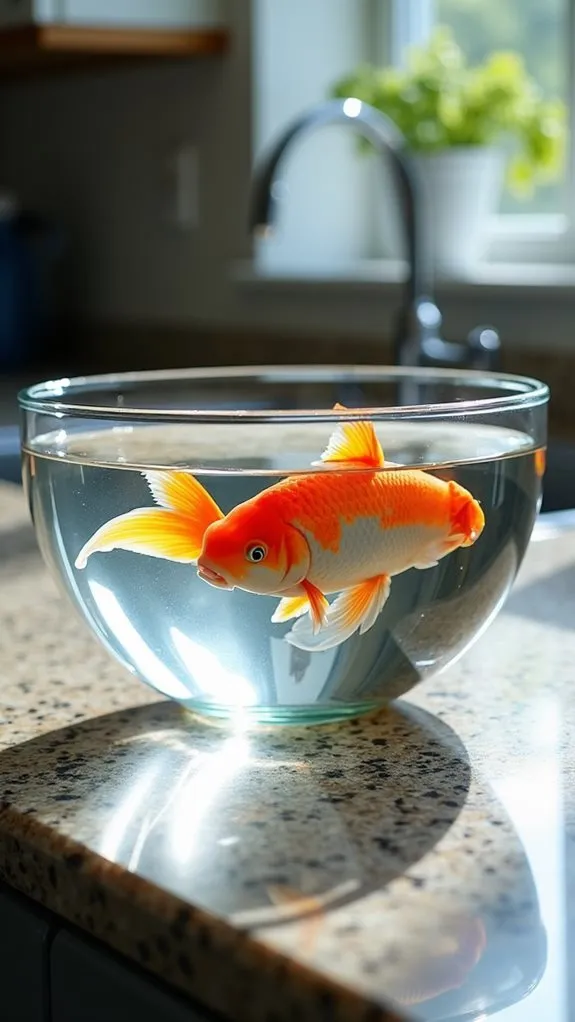
While cleaning your aquarium, choosing the right temporary location for your fish is essential for their well-being. You'll want to select a spot that's calm, quiet, and away from direct sunlight to minimize changes in tank temperature and reduce stress on your finned friends. Maintaining stable water parameters during this period is crucial to ensure your fish remain comfortable.
Think of it as finding the perfect "hotel room" for your fish while their home gets a makeover! Small, clean containers work best for temporary housing to keep your fish comfortable during the process. Following the recommended every other week cleaning schedule helps maintain optimal conditions for your fish.
Your temporary container shouldn't be placed near air vents or windows, as these can cause rapid temperature fluctuations that might affect fish behavior. Instead, opt for a stable surface in a low-traffic area where the container won't get knocked over.
Remember to use a container that's been rinsed with distilled water and filled with existing tank water to keep conditions familiar for your fish.
Don't forget to cover the temporary home – fish can be surprisingly good jumpers when they're feeling adventurous! A simple lid or even plastic wrap with small holes will do the trick.
Keep an eye on your fish during their brief stay, watching for any signs of stress, and you'll have them back in their freshly cleaned home in no time.
Keeping Fish in Their Tank
Most routine tank maintenance tasks can be performed while keeping your fish in their aquarium. You can safely perform water changes, gravel siphoning, and basic glass cleaning without relocating your finned friends. This approach helps minimize stress on your fish and allows them to maintain their normal fish behavior patterns. Regular water changes help maintain healthy water quality for your fish. When you're performing these tasks, it's important to work efficiently and monitor tank conditions closely. You'll want to use a high-quality filtration system and make smaller, more frequent water changes rather than large ones that might disturb your aquatic community. Experts recommend keeping water changes between 10 to 30 percent to avoid stressing your fish. Furthermore, regular water changes can help reduce harmful nitrates that negatively impact fish health.
Think of it like tidying up your house while your family's still home – you want to clean without causing too much chaos!
Remember to avoid overfeeding your fish and maintain regular cleaning schedules to prevent the need for deep cleanings. If you're using cleaning products, make sure they're aquarium-safe to avoid any toxic residue.
Adding products like API Stress Coat can help protect your fish during maintenance. By keeping a close eye on water chemistry and temperature, you'll create a stable environment where your fish can thrive during routine cleanings.
Temporary Tank Setup Tips
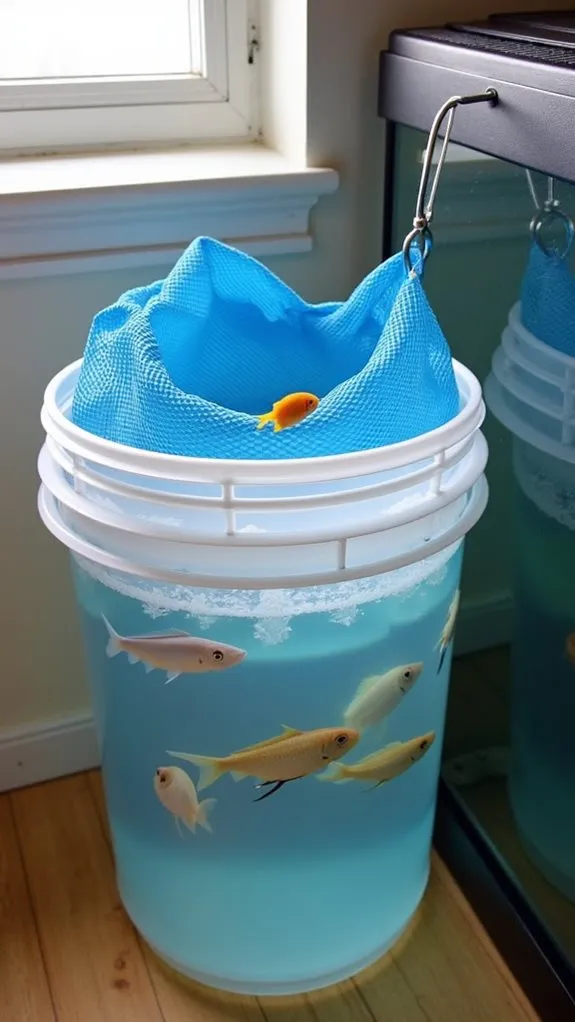
You'll want to match your temporary tank's environment as closely as possible to your fish's original home, including the water temperature and familiar decorations. Maintaining optimal water quality during this process is crucial to prevent stress on your fish.
It's crucial to set up proper aeration equipment, like a gentle sponge filter and an air pump, to keep your fish comfortable and stress-free. Remember to use water conditioner if you're adding fresh tap water to the temporary setup.
Don't forget to add some of your original tank's decorations and water to help your fish feel right at home in their temporary space. Using a clear plastic container can help you better monitor your fish's behavior and well-being during tank maintenance.
Match Original Tank Environment
Creating a suitable temporary environment is essential when moving fish during tank cleaning. Your fish's behavior depends heavily on maintaining familiar conditions, so you'll want to replicate their tank environment as closely as possible. This helps reduce stress and keeps your aquatic friends happy during their temporary stay.
During routine cleaning, fish should stay in the main tank to minimize stress whenever possible. It's important to assess every outlet near your temporary tank setup to ensure proper equipment function. To guarantee a smooth changeover, you'll need to match several key elements from the original tank:
- Transfer some water from the main tank to maintain consistent water parameters
- Use similar substrate and filter media to preserve beneficial bacteria
- Include familiar plants and decorations to provide comfort and hiding spots
- Keep the water temperature identical by using a reliable thermometer, since maintaining optimal temperature helps prevent fish stress.
Don't forget to test the water parameters in your temporary setup before moving your fish. You can use items from your main tank, like plants and decorations, to make the space feel more like home.
Think of it as creating a "mini-vacation spot" that's just as cozy as their regular home. Remember, the closer you match their original environment, the more relaxed your fish will be during their brief stay in the temporary tank.
Proper Aeration Equipment Needed
Proper aeration equipment forms the backbone of any temporary tank setup during cleaning. You'll need to guarantee your fish have adequate oxygen while they're in their temporary home, which is why having the right gear is essential.
Let's go through your essential equipment checklist to keep your finned friends happy and healthy during tank maintenance. A small air stone is a critical component for temporary housing to prevent water stagnation. Maintaining your fish in their temporary setup helps reduce stress levels compared to removing them completely. Additionally, ensuring proper water quality during this period is vital for preventing any negative effects on your fish's health.
Start with a reliable air pump – it's your temporary tank's lifeline. You'll want to pair it with an air stone to create those tiny, oxygen-rich bubbles that'll keep your fish breathing easy.
Don't forget a heater and thermometer to maintain the perfect temperature – fish aren't fans of sudden temperature changes! A sponge filter is your best friend here, as it's gentle on your fish and helps maintain beneficial bacteria.
When setting up your temporary tank, guarantee all electrical equipment is safely positioned and working properly. You'll want to test everything before adding your fish – think of it as a dress rehearsal for your temporary aquatic stage.
Safe Fish Transfer Methods
When you're moving your fish during tank cleaning, you'll want to use a gentle netting technique that keeps them calm and secure. Confirm your temporary container has some of the original tank water and plenty of room for your finned friends to swim comfortably. Additionally, ensure that the temporary water's pH levels are consistent with the main tank to minimize stress during the transfer.
Proper Fish Netting Techniques
Mastering the art of fish netting is essential for safely transferring your aquatic pets during tank maintenance. When it comes to proper netting techniques, you'll want to choose the right net size and guarantee it's free from holes or damage.
Position yourself at tank level, rather than towering over it like a fishing giant, to avoid startling your finned friends.
Here are key fish handling tips to make the process smoother:
- Hold the net closer to the rim for better control and maneuverability
- Use a gentle sweeping motion to guide fish toward the net rather than chasing them
- Lift the net vertically once you've caught your fish to prevent escape
- Keep movements minimal to reduce stress on your aquatic pets
Remember to approach the task with patience – your fish aren't trying to play an underwater game of tag! Additionally, ensure that your chosen tank size is appropriate for the fish you are transferring to prevent any stress during the process from water quality imbalances.
Position the net at an angle in a corner of the tank, and use your free hand to gently guide the fish toward it. If you're dealing with particularly quick swimmers, consider using a coarser mesh net that creates less water resistance.
For smaller fish or shrimp, opt for a finer mesh to guarantee they don't slip through.
Temporary Container Setup
Setting up a temporary home for your fish is a critical step in tank cleaning. You'll want to prepare a clean temporary tank with water from your original aquarium, making sure it's properly covered to prevent any adventurous fish from making a surprise leap.
Think of it as creating a cozy vacation home for your finned friends!
When it comes to fish acclimation, temperature is your top priority. Use a heater if needed to maintain the same temperature as their regular tank, and don't forget to add a few decorations or plants where they can hide and feel secure.
It's like giving them a familiar comfort blanket in their temporary space. It's also important to ensure that the temporary tank maintains ideal water parameters like pH and ammonia levels to prevent added stress.
Transfer your fish using gentle methods, like floating them in bags or carefully guiding them with a cup instead of nets. You'll want to move them in small groups to avoid overcrowding and stress.
Keep a close eye on their behavior during the process – if they're acting unusually stressed, slow down and give them more time to adjust.
Minimizing Transfer Stress
The safe transfer of fish between tanks requires careful attention to minimize stress and prevent injury. When you're cleaning your tank, using proper acclimatization methods can make a huge difference in your fish's well-being.
You'll want to choose between the floating bag method or drip acclimation, depending on your fish's sensitivity.
To guarantee successful stress reduction during transfer, follow these essential steps:
- Stop feeding your fish 24 hours before the move to reduce waste
- Keep the lights off during and after the transfer process
- Use clean, covered containers that are dark-colored to keep fish calm
- Monitor your fish closely for any signs of distress
If you're using the floating bag method, you'll need to let the bag float for 15-20 minutes while gradually adding tank water.
For more sensitive fish, drip acclimation might be your best bet – just remember to maintain a slow drip rate of 2-3 drops per second. Additionally, maintaining a stable pH level is vital for a smooth transfer, as fluctuations can further stress your fish.
Whatever method you choose, don't rush the process. Think of it like helping your fish adjust to their temporary "vacation home" – they'll appreciate your patience and care!
Water Quality Management
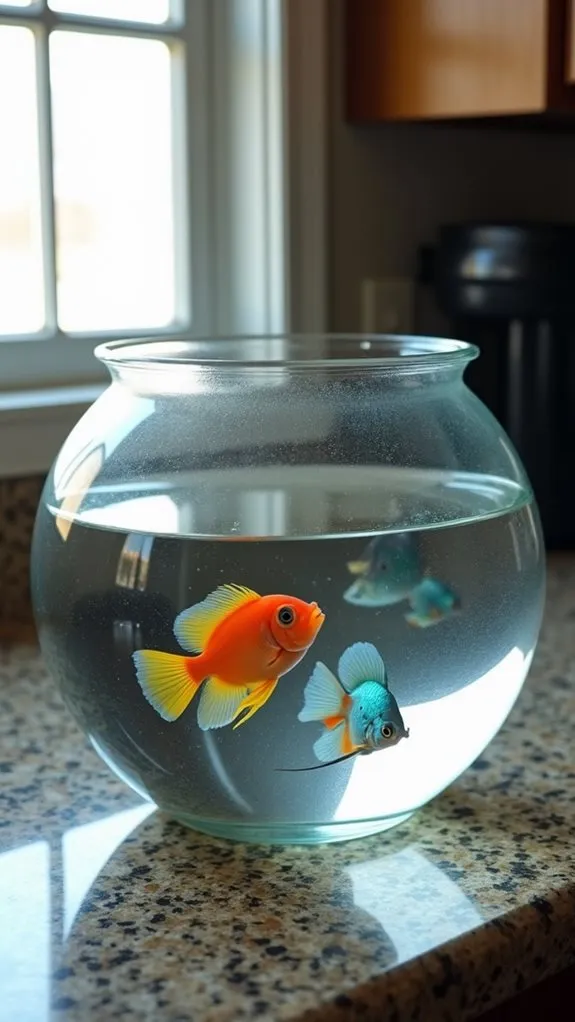
Proper water quality management serves as the foundation of a healthy aquarium environment. You'll need to keep a close eye on your water chemistry through regular testing, as it directly impacts your fish health.
Think of it as being your aquarium's personal chemist – you're monitoring everything from ammonia levels to pH, making sure your finned friends have the perfect swimming conditions.
Your weekly maintenance routine should include changing about 25% of the water while using a siphon to vacuum up any debris hiding in the gravel.
Don't forget to treat your tap water with a conditioner to remove harmful chlorine and chloramines – your fish will thank you for it!
When it comes to filtration, you'll want to clean your filter media regularly, but here's the trick: don't go overboard with cleaning, as you need to protect those beneficial bacteria that keep your tank's ecosystem balanced. Regular testing of ammonia and nitrite levels is essential to identify potential issues early and maintain a stable environment.
Remember to use only dedicated aquarium tools for cleaning, and always turn off your equipment before getting started.
Think of maintaining water quality as being a responsible fish parent – it's all about creating a clean, stable home for your underwater family.
Stress Reduction Techniques
You'll find that keeping your fish inside the tank during cleaning is much less stressful than moving them to a temporary container.
When you're working on the tank, make sure your movements are slow and deliberate to avoid startling your finned friends with sudden jolts or vibrations.
If you're adding new water during maintenance, you'll want to match the temperature perfectly with your existing tank water, as even small temperature differences can shock your fish.
Minimize Sudden Tank Movements
Minimizing sudden movements during tank maintenance is essential for keeping your fish calm and stress-free. Proper stress management starts with understanding how your actions affect tank stability.
When you're cleaning your aquarium, make deliberate, smooth movements to avoid startling your aquatic friends.
Here are key practices to maintain a peaceful environment during tank maintenance:
- Turn off all equipment (filters, heaters, lights) before starting any cleaning tasks
- Use slow, controlled movements when introducing cleaning tools into the water
- Add fresh water gradually during water changes to prevent sudden parameter shifts
- Handle decorations and equipment gently to minimize vibrations in the tank
Keep Fish Inside Tank
The most effective way to reduce stress during tank cleaning is to keep your fish inside their aquarium. When you observe fish behavior during maintenance, you'll notice they're much calmer when they remain in their familiar environment. Instead of catching and relocating them, which can trigger intense stress signals, work around your finned friends while cleaning.
To make this method successful, you'll want to guarantee there's plenty of water left in the tank for your fish to swim comfortably. Using a gravel siphon, you can remove debris while your fish go about their regular activities – they might even think it's an exciting new toy!
Remember to maintain hiding spots with decorations, as these serve as safe spaces where your fish can retreat if they're feeling anxious.
Regular, gentle maintenance is key to keeping stress levels low. By performing frequent partial water changes and maintaining consistent water parameters, you'll create a stable environment that doesn't require dramatic cleaning sessions.
Keep your movements slow and methodical, and you'll find your fish will become more comfortable with your presence during cleaning time.
Match Water Temperature Perfectly
Matching water temperatures precisely stands as one of the most essential steps in reducing fish stress during tank maintenance.
You'll want to guarantee proper temperature acclimation when transferring your finned friends to their temporary home and back again. Think of it like jumping into a pool that's too cold – not fun for anyone, including your fish!
Here's what you need to do to maintain ideal water parameters during cleaning:
- Use a reliable digital thermometer to match temperatures exactly between the main tank and temporary container
- Prepare your cleaning water at least 24 hours in advance to stabilize temperature and chemistry
- Monitor temperatures throughout the entire cleaning process, making adjustments as needed
- Keep both containers in the same room to minimize temperature fluctuations
Remember that even small temperature differences can stress your fish, so take your time with this process.
If you notice your fish showing signs of stress, slow down the temperature adjustment process. Changes should occur gradually, no more than 1-2°F at a time.
Your patience here will go a long way in keeping your aquatic pals happy and healthy during their brief relocation.
Equipment You Will Need

Proper tank maintenance requires several essential tools to safely clean your aquarium and temporarily house your fish. To make your cleaning routine efficient and stress-free, you'll need to prepare a complete equipment checklist before you begin.
Start with the basics: a reliable gravel siphon for waste removal, an algae scraper suited to your tank material (glass or acrylic), and a sturdy bucket for water changes.
You'll also need a water conditioner to treat tap water and remove harmful chlorine. Don't forget to have a separate bucket ready for rinsing filter media – you never want to use soap or tap water directly on these materials!
For more thorough cleaning, you might want to invest in a magnetic cleaner for easy algae removal, aquarium tweezers for precise plant maintenance, and a quality net for handling your fish.
If you're dealing with stubborn algae, a razor cleaner can help, but use it carefully to avoid scratching the tank.
Consider adding some natural cleaners to your setup, like Amano shrimp or nerite snails, which can help maintain cleanliness between major cleaning sessions.
Cleaning Without Fish Removal
During routine tank maintenance, you can effectively clean your aquarium while keeping fish in their natural environment. This approach minimizes fish stress and helps maintain a stable ecosystem.
When you're performing tank cleaning, you'll want to follow specific safety measures to protect your aquatic friends.
Here are the essential steps for a successful cleaning while keeping your fish in the tank:
- Turn off all electrical equipment before you begin cleaning to guarantee everyone's safety (including yours!)
- Use a gravel siphon carefully, lifting it if fish get too curious – they can be quite nosy during cleaning time
- Clean one-third of the substrate per session to maintain beneficial bacteria
- Keep the water temperature consistent when adding new water – your fish don't appreciate sudden cold showers!
Remember to perform regular water changes, but don't go overboard – 10% weekly or 25% every other week is plenty.
While cleaning, you'll want to remove decorations and plants to clean them separately, but leave your finned friends where they're most comfortable.
Keep an eye on the water level to guarantee your fish have enough room to swim, and never use soap or chemicals that could harm them.
Tank Maintenance Best Practices
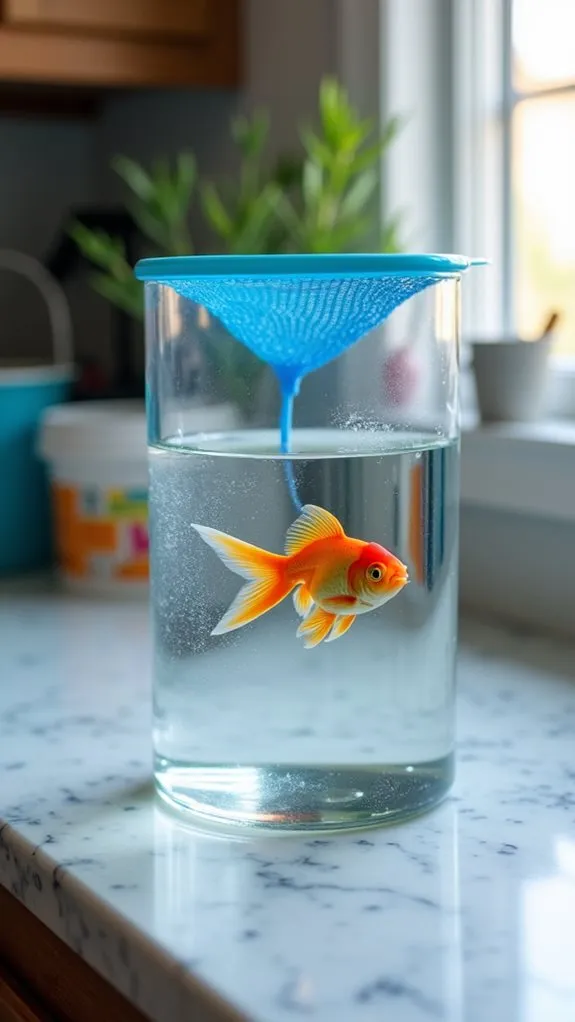
A tank's long-term health depends on consistent and thorough maintenance practices. You'll want to establish a regular cleaning schedule that keeps your aquatic friends happy while minimizing their stress. For most established tanks, performing a 10-25% water change every week or two will help maintain ideal conditions.
When it comes to tank filter cleaning, you'll need to be strategic about timing and technique. Clean your filter media in old tank water, not tap water, to preserve beneficial bacteria that help keep your aquarium balanced. Remember, you're aiming for fish stress management, so don't go overboard with cleaning – sometimes less is more!
Your maintenance routine should include regular water testing, substrate vacuuming, and glass cleaning. Keep your cleaning supplies organized and dedicated to aquarium use only – you don't want to accidentally introduce any harmful chemicals into your fish's home!
Schedule these tasks at consistent intervals, and you'll find it becomes second nature. Think of it like housekeeping for your underwater pals – they can't tidy up after themselves, so they're counting on you to keep their home clean and comfortable.
Emergency Fish Housing Options
In the midst of tank cleaning, you'll need a safe temporary home for your fish. When it comes to fish relocation, you'll want to choose containers that are both spacious and secure. Your temporary housing options should prioritize your fish's comfort and safety while maintaining stable water conditions.
Here are essential items you'll need for setting up emergency fish quarters:
- Large, clean buckets or containers that haven't been exposed to chemicals
- A reliable air pump or battery-operated aerator for oxygen
- Decorations or plants from the original tank to provide hiding spots
- A secure lid or covering to prevent jumping
When selecting your temporary housing solution, make sure it's large enough to accommodate your fish comfortably – nobody likes a cramped hotel room, even if it's just for a few hours!
Keep the container in a quiet spot away from direct sunlight and sudden temperature changes. You'll want to use water from your existing tank to fill the temporary home, as this helps reduce stress on your finned friends.
Remember to monitor your fish closely during their brief stay in their temporary quarters, watching for any signs of distress.
Frequently Asked Questions
How Long Can Fish Survive in a Bucket Without a Filter?
Your fish can survive 1-2 days in a bucket without a filter. You'll need to monitor water temperature and oxygen levels closely. For better survival rates, you should add an air pump.
Can I Use Plastic Food Containers as Temporary Fish Housing?
Yes, you can use food-grade plastic containers for temporary housing, but make certain they're clean and chemical-free. For your fish's safety, only use containers specifically labeled as food-grade to prevent harmful toxin leeching.
Should I Feed My Fish Before or After Cleaning the Tank?
You can feed your fish either before or after tank cleaning. If you're using messy foods, feed before cleaning to remove waste. For regular foods, wait a few hours after cleaning to maintain your feeding schedule.
What Signs Indicate My Fish Are Too Stressed During Cleaning?
Watch for these fish behavior stress indicators: erratic swimming, hiding, rapid breathing, clamped fins, and color changes. You'll also notice if they're glass surfing or showing unusual aggression toward tank mates.
Can I Use the Same Net for Different Fish Tanks?
You shouldn't use the same net between tanks unless you properly sanitize it first. This prevents cross-contamination during fish transfer. For best net hygiene, consider having separate nets for each aquarium.
Final Thoughts
You've now got all the tools and knowledge you'll need to safely house your fish during tank cleaning. Whether you're using a temporary container, keeping them in the tank, or opting for a partial water change, remember that your fish's comfort and safety come first. By following these guidelines and maintaining proper water conditions, you'll make tank cleaning day stress-free for both you and your aquatic friends.



